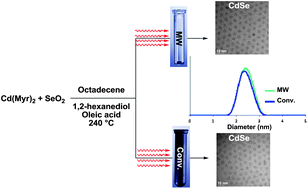Microwave-assisted synthesis of CdSe quantum dots: can the electromagnetic field influence the formation and quality of the resulting nanocrystals?
Abstract
Microwave-assisted syntheses of colloidal

* Corresponding authors
a
Christian Doppler Laboratory for Microwave Chemistry (CDLMC), Institute of Chemistry, Karl Franzens University Graz, Heinrichstrasse 28, A-8010 Graz, Austria
E-mail:
mostafa.baghbanzadeh@uni-graz.at, oliver.kappe@uni-graz.at
b Anton Paar GmbH, Anton-Paar-Str. 20, A-8054 Graz, Austria
Microwave-assisted syntheses of colloidal

 Please wait while we load your content...
Something went wrong. Try again?
Please wait while we load your content...
Something went wrong. Try again?
M. M. Moghaddam, M. Baghbanzadeh, A. Keilbach and C. O. Kappe, Nanoscale, 2012, 4, 7435 DOI: 10.1039/C2NR32441E
To request permission to reproduce material from this article, please go to the Copyright Clearance Center request page.
If you are an author contributing to an RSC publication, you do not need to request permission provided correct acknowledgement is given.
If you are the author of this article, you do not need to request permission to reproduce figures and diagrams provided correct acknowledgement is given. If you want to reproduce the whole article in a third-party publication (excluding your thesis/dissertation for which permission is not required) please go to the Copyright Clearance Center request page.
Read more about how to correctly acknowledge RSC content.
 Fetching data from CrossRef.
Fetching data from CrossRef.
This may take some time to load.
Loading related content
